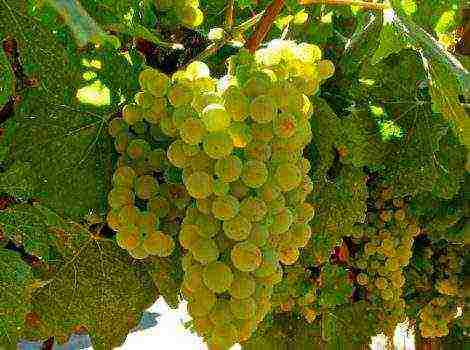Content
- 1 Winter varieties of apple trees
- 2 Useful videos
- 3 Zaluchenie
- 4 Winter varieties of apple trees with photos and descriptions
- 5 The best winter varieties of apple trees for the Moscow region
- 6 The latest varieties of winter apple trees
- 7 Why are late apple varieties good?
- 8 Idared
- 9 Antaeus
- 10 Bogatyr
- 11 Jonathan
- 12 Lobo
- 13 Mac
- 14 Red Delicious
- 15 Renet Simirenko
- 16 Sinap Orlovsky
- 17 Early winter apple varieties
- 18 Winter varieties of apples stored until spring
- 19 Late winter apple varieties
 Considering that the natural conditions of our region do not allow growing fresh vegetables and fruits all year round, an important problem is the safety of grown products until the next harvest. And winter varieties of apples will help in solving this problem.
Considering that the natural conditions of our region do not allow growing fresh vegetables and fruits all year round, an important problem is the safety of grown products until the next harvest. And winter varieties of apples will help in solving this problem.
Late apples ripen and pour slowly, accumulating vitamins, and during the ripening period, the proportion of aromatic substances increases, therefore, they are much healthier and tastier than early-ripening apples.
To enjoy fresh apples all year round, it is necessary to select varieties apples for the garden and set aside enough space to grow good winter varieties, which in turn also differ in taste and shelf life.
Attention! Winter apples acquire their best taste and aroma during storage: after two weeks, up to a month or more.
 They can be divided into three groups:
They can be divided into three groups:
- early winter - until February;
- winter - until April;
- late winter - winter varieties with a long shelf life of fruits.
We present to your attention the best winter varieties for long-term storage.
Winter varieties of apple trees
Idared
Late winter medium-sized. Apples have a conical shape with rounded edges, apple weight - 150-190g. The main color of the fruit is green, the top color is a reddish blush. The structure is dense, the taste is juicy, sweet and sour.
Medium scab resistant. Begins to bear fruit 5-6 years after planting. Harvesting is carried out at the end of September, stored until mid-spring.
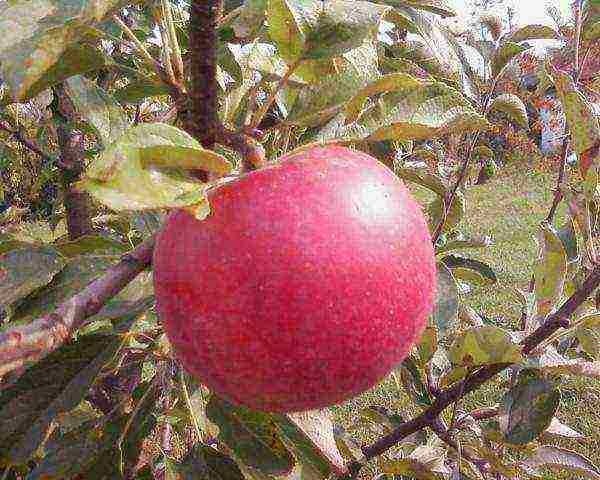
Idared.
You can see detailed photos and description of the Idared variety here.
Antaeus
Late winter sweet grade. Trees grow up to 2-2.5m.
The fruits are juicy, weighing 180-200g, have a dense, homogeneous pulp. The apples are very aromatic. They are collected in early October. When ripe, they acquire a burgundy or dark red color.
The fruits are stored until April. Apple trees have good resistance to low temperatures.
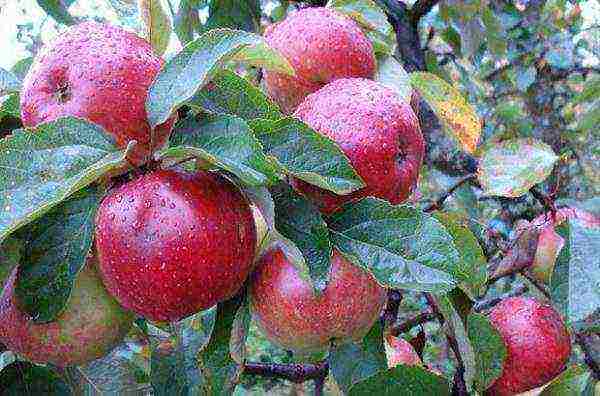
Antaeus.
You can find more information about the Antey apple tree here.
Alesya
Late winterreaching a size of 3.5-4.0 m in height. Variety early, begins to bear fruit at the age of 3-4 years. Apple tasting score 4 points. Apples are sweet and sour, juicy, weighing 150-200 g with a weak aroma and a fine-grained structure.
Differs in high productivity, regularity of fruiting, resistance to scab and adverse weather conditions. It is grown mainly on a medium-sized rootstock. Stored until May.

Alesya.
You will learn more about the apple tree Alesya from this article.
Antonovka
Early winter a variety of old selection. The tree is generally tall, but it is also medium-sized. The growth of a tree on a low-growing stock is 3.0-4.0 m, on a seed stock - 4.0 -6.0 m. Plants have a wide crown, branches are thick and strong. On a low-growing rootstock, it quickly begins to bear fruit.
The pale green basic color of the fruit becomes light yellow when fully ripe. Fruit weight -150-170g. The sweet and sour taste of apples has a unique wine aroma. Stored until mid-December. The pulp is juicy, dense, grainy, loosened during long-term storage.
The predominance of acidity in the taste allows it to be used in cooking and peeing apples.
It is a good pollinator for other varieties.
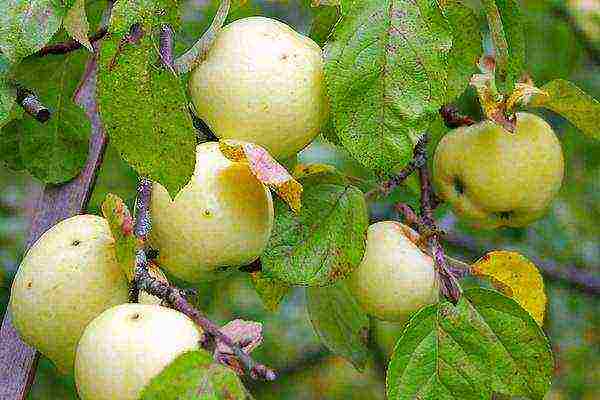
Antonovka.
You can read more about the Antonovka apple tree here.
Belarusian synap
Late winter grade. A medium-sized plant reaches a height of 2-2.5 m. The crown is pyramidal, not thickened. Begins to yield crops for 2-3 years.
Apples weighing 200-250 g, possess sweet and sour taste, with a pleasant juicy texture and delicate aroma. The fruits are stored until the next harvest.
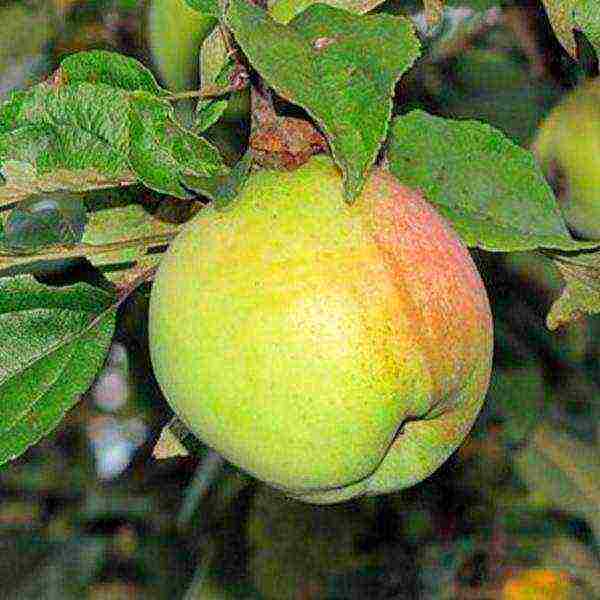
Belarusian synap.
Bogatyr
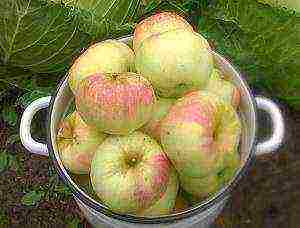 Variety refers to late winter... The taste of apples is sweet and sour. Fruits are strong, crunchy, strong, aromatic. The color is light green; during storage, it turns yellow or acquires a slight blush.
Variety refers to late winter... The taste of apples is sweet and sour. Fruits are strong, crunchy, strong, aromatic. The color is light green; during storage, it turns yellow or acquires a slight blush.
Advantages:
- winter hardy;
- drought-resistant;
- scab resistant;
- productive;
- has a good presentation;
- high transportability.
Main characteristics:
- tree growth - 2-3m;
- entry into fruiting - 5-6 years;
- apple weight - 150-190g;
- harvesting period - end of September;
- the duration of the storage of apples is until March.
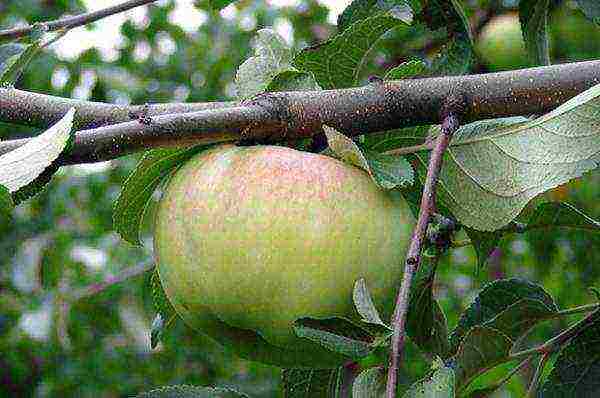
Bogatyr.
You can find more information about the Bogatyr apple here.
Golden Delicious
Late winter grade. It is cultivated with medium and vigorous rootstock. The growth of a tree on a low-growing rootstock reaches 2.0-3.0 m, on a vigorous rootstock - 4.0-6.0 m. It begins to bear fruit on a low-growing rootstock for 2-3 years, on a strong-growing rootstock - 5-6 years. The crown of the tree is wide and dense. A pollinator variety is required.
It has a wonderful sweet taste that does not get worse with prolonged storage. Apples weighing 150-200g have a slightly oblong shape and golden color. The pulp is juicy, crispy, the skin is dense, but thin, resistant to mechanical damage.
Low temperature resistance - high, transportability - good, susceptible to damage by powdery mildew and brown spot. The apples are harvested in September and stored until mid-spring.

Golden Delicious.
You will learn more about the Golden Delicious apple tree in this article.
Darunak
Late winter grade. Fruits of an attractive purple color with a thin, elastic skin, slightly asymmetric, with a slight ribbing. The taste is pleasant, delicate, sweet and sour. Good resistance to low temperatures, high scab resistance and natural unpretentiousness, ease of care are its advantages.
Main characteristics:
- tree growth - 3.5-4m;
- entry into fruiting - 3-4 years;
- apple weight - 120-160g;
- harvesting period - late September - early October;
- the duration of the storage of apples is until March.
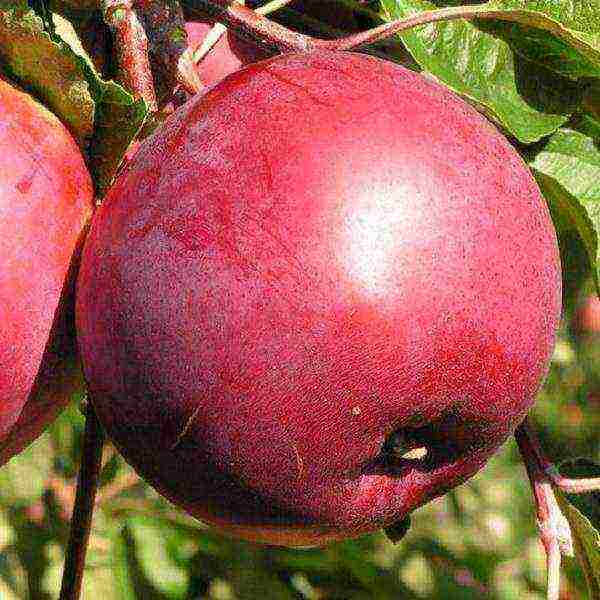
Darunak.
You can read more about the Darunak apple tree here.
Jonathan
Late winter apple variety of North American origin. Its other names: Osmalovskoe, Horoshavka winter, Winter red.
The tree is medium-sized, 2.5-3.0 m high. Prefers fertile, well-moistened soils. Has good resistance to scab and powdery mildew.
The fruits are juicy, dense, weighing 150-190g, by the end of ripening they acquire a red blush, have a sweet and sour taste and a weak spicy aroma. Tasting score 4.5 points. Fruits are stored until March.

Jonathan.
Read more about the Jonathan apple tree in this article.
Lobo
An early winter variety with excellent taste characteristics. Has a high yield and annual fruiting. Among the advantages are drought resistance and winter hardiness. Fruits are juicy, dense, rounded, weighing 100-180 g, deep red.
Main characteristics:
- tree height - 3.4-4.0 m;
- the beginning of fruiting -4-5 years;
- harvesting period - late September - early October;
- the duration of storage of apples is until January.
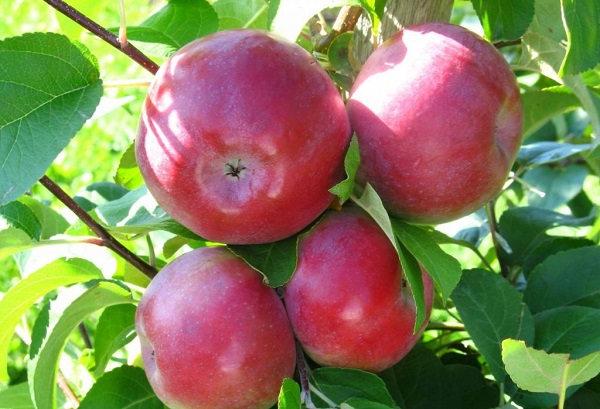
Lobo.
You can find more information about the Lobo apple tree here.
Mac
Early winter sweet variety. The main color is light yellow, covered with purple or dark red stripes on top. Ready to eat a couple of weeks after taking off. The trees have an average winter hardiness and are susceptible to fungal diseases.
Main characteristics:
- tree growth - 3.5 - 4.0 m;
- entry into fruiting - 150-180g;
- harvesting period - late September - early October;
- the duration of storage of apples is until January.

Mac.
You will learn more about the Macintosh apple variety in this article.
Pepin saffron
The oldest, most popular late winter variety in the Russian Federation. The yield is high, but fruiting in adulthood is characterized by periodicity. Begins to bear fruit in 5-6 years.
The apples are small enough, weighing 70-80g, strong, have an elongated, ovoid shape. They are ruddy on the top, and the main color is light green. The taste of the fruit is sweet, and the aroma is spicy, with a wine aroma.
Winter hardiness and disease resistance - average. Recovers quickly from damage. Harvested in late September - early October and stored until March.
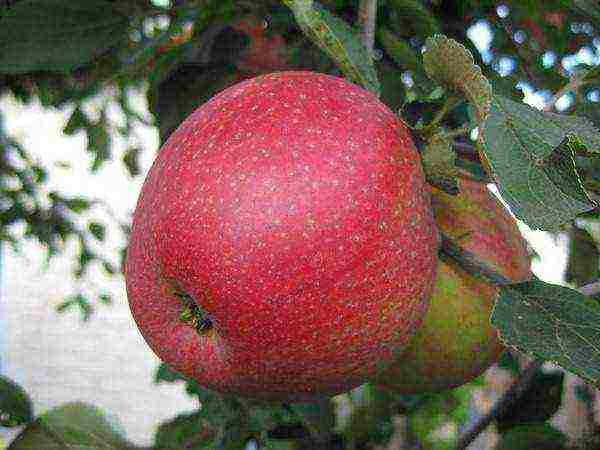
Pepin is saffron.
You can read more about the apple variety Pepin saffron here.
Red Delicious
Medium winter apple tree, reaching a size of 4.0-6.0 m. The crown is wide, slightly pyramidal, and its fruits are large. The commercial qualities are high, the transportability is good.
Apples are prized for their sweet taste. The bright red color of the fruit attracts the attention of consumers. The cleaning period is September-October. Duration of storage of apples - until February.
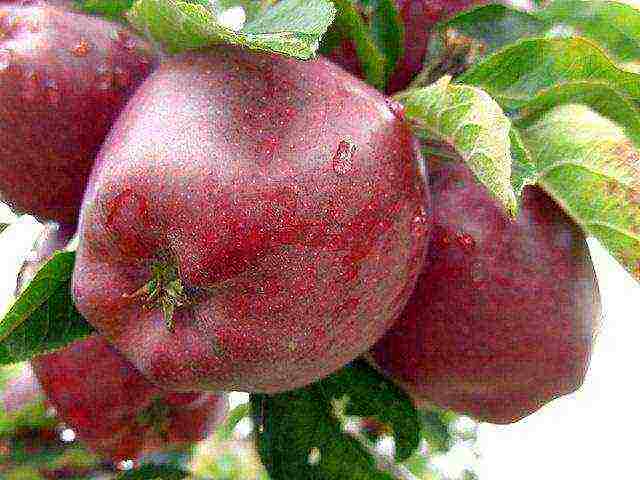
Red Delicious.
Read more about the Red Delicious variety in this article.
North synap
Late winter variety with a wide, powerful, pyramidal crown. Medium-sized tree... High yield, average drought resistance and scab resistance are the dignity of the variety. In addition, the North Sinap is a winter-hardy apple tree variety. Harvesting maturity occurs relatively late - by the beginning of October.
Advice! Unripe apples do not provide high taste, therefore, harvesting must be carried out when the fruits acquire a beautiful appearance and a ruddy casing color and are fully ripe.
Main characteristics:
- tree growth - 4.0-6.0 m;
- the beginning of fruiting - 6-8 years;
- apple weight - 120-170g;
- harvesting period - late September - early October;
- the duration of storage of apples is until April.
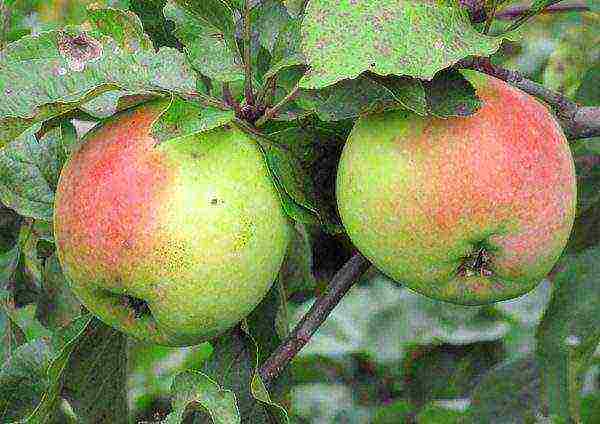
North synap.
You can find more information about the North Synap apple tree here.
Sinap Orlovsky
Variety winter, with a tall wide crown, reaching - 3.0-4.0 m. Fruits are green with a slight blush, large, weighing 200-250 g, the same size, have a good presentation. The pulp is dense, juicy, sweet, with a slightly perceptible sourness.
Possesses good resistance to difficult weather conditions and diseases. The crop is harvested at the end of September and store until March.
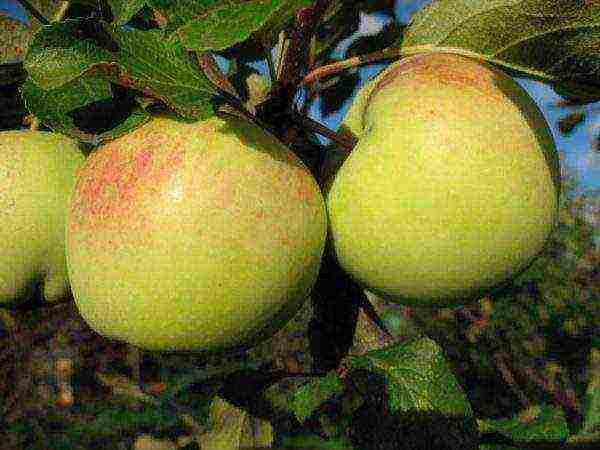
Sinap Orlovsky.
You will learn more about the Sinap Orlovsky apple variety in this article.
Useful videos
Watch a video with a brief description of the winter varieties of apple trees:
Watch a video review of the apple tree expert Golden Delicious:
Watch a video of what the Lobo apple tree looks like:
Watch a video of what the North Synap apple tree looks like on a dwarf rootstock:
Zaluchenie
Growing winter varieties of apples allows not only to extend the shelf life, but also preserve the unique taste and aroma of fruits and their nutritional value.
Later harvesting dates for winter apples will allow you to rationally plan autumn work and free up time for processing the harvest.
And rememberamong winter apple trees there are frost-resistant varieties, but not all of them are!
Most of the orchard of most summer residents and gardeners are apple trees. They grow best in mild climates. Despite this, they can be grown in less favorable weather. The most common are the winter varieties of apple trees.
Among the advantageous properties, resistance to low temperature conditions and, of course, a rather long period of storage of fruits are noted. Depending on the variety type, a person can enjoy fresh fruits all winter, from about 4 to 8 months they do not lose their qualities. The maximum border in this regard is the beginning of July. At this time, the early species of this fruit are already ripening. In other words - growing early and late apples, you can eat them all year round. But you should definitely adhere to the appropriate storage rules and temperature conditions. It is noteworthy that during storage, fruits do not lose their taste properties, as well as the level of starch and protopectin (a substance that allows you to establish the functionality of the body by removing toxins and harmful compounds).
Since the birthplace of this tree is a temperate zone, the largest apple-producing countries are located in this climatic zone (Germany, France, Ukraine, Italy, Russia, England, Poland, as well as the USA and China). It is here that the best winter varieties of apple trees are bred and rich harvests are collected.
Winter varieties of apple trees with photos and descriptions
Almost all varieties of winter apple trees (see photo with the name) have an excellent aroma, and it can be preserved for a long time. The peel of all winter-hardy fruits is much thicker than that of early and mid-early fruits. This also applies to the pulp - it is harder. These features provide resistance to damage, prevent decay processes, which means that the quality of the fruit is ensured even during long-term storage.
It should be noted that winter varieties of apple trees (reviews of experienced summer residents confirm this) are not always suitable for human consumption, if they are only plucked from the tree. Fruits do not yet have such a rich taste, and many of them can be sour. The period of full ripening begins in about 4-7 weeks, the fruit should be well laid down.
The hardy species of these fruit trees are classified into three categories:
- Early winter... The approximate shelf life dates from the end of February (Pepin Saffron, Uelsi, Pobeditel, Antonovka ordinary, Winter gold Parmen).
- Average winter... You can eat the fruits until the beginning of May (Aport, Lobo, Anis Seryi, Antonovka dessert, Ranet, Sinap Orlovsky, Mirnoe, Kortland).
- Late winter... According to the shelf life, they are the most stable, they can lie until the beginning of July (North Sinap, Mantuan, Renet Orleans, Sarah Sinap).
The best winter varieties of apple trees for the Middle Lane:
- Jonathan... This is an American selection known to gardeners as Winter Red. A scarlet blush covers the fruits of medium-sized trees almost completely closer to harvest. Jonathan apples are delicious. After planting a young tree in the soil, a bountiful harvest can be expected in four years. Such winter varieties of apple tree seedlings do not exceed 3-3.5 m in height. On average, the fruits have about one and a half hundred grams of weight. The approximate shelf life is 160 days.
- Semerenko... One of the best varieties of winter-hardy apple trees of Ukrainian selection. Named after its creator, breeder L.P. Semerenko. The main property is the preservation of taste and original aroma even after long-term storage. The deadline is 6 months. At the end of this period, the apples may lose their shape slightly and become a little sluggish. As for the yield, summer residents on average collect from 60 to 100 kg. fruit from the apple tree. Winter varieties are in great demand in Ukraine. Fruit color is rich green. It is preserved throughout the entire ripening period. During storage, the fruit may acquire a mild yellowish tint. The shape of the apples themselves is round, slightly flattened at the poles.
- Antaeus... Belongs to the category of late winter varieties of apple trees. Belarus is the birthplace of Anthei. The description says that trees can tolerate fairly low temperatures.The fruits are juicy and have an incomparable taste. During the growing season, they change their color from bright green to burgundy. A notable feature is the presence of a waxy coating on the skin of the fruit, which gives it a slightly bluish tone. Antey apples are fully ripe 8 weeks after harvesting. An adult tree does not exceed 2.5 m in height. It is very convenient to pick weighty fruits (about 0.2 kg. Each) from a tree. When stored properly, the fruit can be eaten until mid-summer.
- Winter Beauty... This is the result of the work of Russian breeders (the authorship belongs to the amateur breeder Kamendzhrovsky E.M.). Fine fruits have a rich taste and mild aroma. In large fruits, which can reach from 180 to 400 gr. weight, the best qualities of two varieties are combined - this is Red Delicious and the favorite of many gardeners, Antonovka ordinary. It was on their basis that a wonderful variety of apple trees, Winter Beauty, was created. The description of these winter-hardy apples characterizes it on the positive side. They are endowed with excellent properties and have a dessert taste, have a long shelf life, and are very resistant to winter cold. The fruits have a bright green color, which then acquire a delicate yellow tint. The apples are rounded with a slightly elongated bottom. This variety thrives best in the Northwest and Central regions.
- Mac... We can say that this is the most unique variety of winter apple trees. Red fruits in the form of a balloon ripen, practically, earlier than all winter-hardy varieties. This is the result of the work of Canadian breeders. Macintosh has an unsurpassed taste that can be fully enjoyed no earlier than a month after harvesting the fruit. The trees are quite tall - 3.5-4.5 m. The average weight of the fruit is about one and a half hundred grams.
- Antonovka... The most popular apple tree. Winter resistant varieties like this one do not have such a bright zest that Antonovka has - a sour taste that only emphasizes its unsurpassed taste. The apples are very aromatic, tasty and bright. It is impossible to confuse them with any other species. Its fruits are yellowish-creamy. They are quite weighty (200-300 g). Among the advantageous properties, it should be noted excellent frost-resistant characteristics and a long shelf life.
- Winter lungwort... Belongs to the autumn-winter varieties of apple trees with an average ripening period. Young seedlings can produce crops as early as 4 years after rooting in the main soil. Fruits are harvested at the beginning of October. Up to one centner of ripe fruit can be harvested from one mature tree. Apples are stored until early March. The apple variety Winter Medunitsa tolerates frost very well. An insignificant disadvantage can be considered a slight loss of taste at the end of the scheduled storage period. The taste of ripe and matured (about 5 weeks) apples can be described as fresh sweet with medium juiciness.
- Bogatyr... One of the most versatile winter varieties of apple trees. For Siberia, for the Urals and for the entire Middle Belt, there is no better option. It belongs to the late winter category and is one of the most popular among summer residents and gardeners. The Bogatyr sapling can withstand very low temperatures, so it is suitable even for northern latitudes. The shade of strong, firm and aromatic fruits is light green. Ripe apples may develop a slight red blush. Fruiting very early. Harvesting can be done at the end of September. The fruits have an average weight of 0.2 kg. Mature trees are slightly taller than a person, which ensures an unhindered and high-quality harvest of ripe apples. The taste of the fruit is predominantly sweet, a slight sourness is felt.
The best varieties of winter apple trees are also:
The best winter varieties of apple trees for the Moscow region
Experienced gardeners of the Moscow regions allocate about 50% of the garden area for winter-hardy varieties of apple trees. This is due to the special climatic conditions of this region. The criteria for choosing winter varieties of apple trees for the Moscow region are characterized by the endowment of such qualities as disease resistance, fruiting period, frost resistance, and yield. In this regard, some of the best apple trees are:
Also, special emphasis is placed on the columnar shape, especially in those areas, the area of which is limited. As a rule, the columnar shape can be grafted into any variety. This is done by grafting cuttings of any compatible variety. The best winter varieties of columnar apple trees for the Moscow region with a photo:
The latest varieties of winter apple trees
No matter how good the classic and popular varieties of winter-hardy apple trees are, summer residents and gardeners are looking for new items. Breeding work does not stop. The result of the work of agricultural enterprises and private gardeners is new products that are rapidly gaining popularity and are being successfully grown. These are the latest varieties of winter apple trees:
In addition to these new products, there are the following varieties of winter-hardy apple trees: Toshiro Fuji (China), Evelina (Russia), Beni Shogun (USA), Rubinette-Katerina (Ukraine).
If we talk about practical tips for choosing a fruit tree for growing in your garden, then in addition to studying theoretical material, you need to independently evaluate the taste of apples and determine whether they match your preferences.
It is generally accepted that red is the only sign of a ripe fruit. However, most often only winter varieties of apple trees can please with this color. Which of the late varieties are the tastiest?
Choosing winter seedlings, or, as they are also called, late apples, there are several important factors to consider. Winter apples do not acquire their optimal taste immediately after harvesting, but within a few weeks or even months after harvest. In addition, the trees of such apple trees have increased winter hardiness and can easily endure both severe frosts and recurrent cooling after a thaw.
Why are late apple varieties good?
The main distinguishing feature of late apples is increased keeping quality... They are perfectly preserved until spring (some varieties are stored until summer) and at the same time do not lose their original taste and aroma. They are usually removed in late September - early October in the phase of removable maturity. The fruits at this time contain a lot protopectin and starch... During ripening, the proportion of coloring and aromatic substances in them increases.
Late apples become completely ready for consumption after a few months. Their shelf life, depending on the variety and environmental conditions, ranges from 4 to 8 months.
Benefits later varieties of apples are:
- long shelf life;
- apples ripen and acquire a stable taste and aroma;
- dense texture and firm peel;
- good transportability;
- suitability for any kind of processing.
Late varieties of apples are also differentiated by shelf life by:
- early winter (Antonovka ordinary, Winner, Pepin saffron, Parmen winter gold, Welsey) - stored until January-February;
- winter (Anise scarlet, Anise gray, Antonovka dessert, Aport, Kortland, Lobo, Mirnoe, Ranet bergamot, Northern Sinap, Sinap Orlovsky) - stored until March-April;
- late winter (Mantuan, Sary Sinap, Renet Orleans, Renet Champagne, North Sinap, etc.) - stored until May-June.
The main difference between winter and summer varieties of apples is that they are undesirable to eat right away - they must lie down for at least a month.
Idared
Late winter tall variety. Fruits are slightly conical in shape with small blunt or slightly angular ribs. Initially, they are green, when exposed to the sun, they are covered with yellow and red blush. The taste is pleasant, with a dense and juicy pulp.The variety is resistant to brown spot, but susceptible to diseases of powdery mildew and scab. They are consumed not only fresh, but also used to prepare compotes, dried fruits and juices.
| Entering fruiting | Tree height (m) | Fruit weight (g) | Harvest | Shelf life (days) | |
|
For 5-6 years |
2-3 |
150-190 |
End of September |
150-180 | |
Antaeus
A late variety of apples obtained by Belarusian breeders. Possesses increased frost resistance and perfectly tolerates even the most severe winters. Juicy and sweet fruits do not lose their aroma for a long time. As they ripen, they change color from green to bright red and burgundy. They often have a waxy coating that gives a bluish tint. The consumer ripeness of the fruit occurs 2 months after picking. They can be consumed both fresh and harvested for future use.
| Entering fruiting | Tree height (m) | Fruit weight (g) | Harvest | Shelf life (days) | |
|
2-3 years |
2-2,5 |
180-200 |
Second half of September - early October |
200-240 | |
Bogatyr
A variety that bears fruit in almost any climatic zone. It was created as late winter, the fruits are very hard and strong, under good conditions they can lie until the end of May. They have a pleasant sweet and sour taste. Until harvesting, the color of the fruit remains light green, during maturation, they turn yellow, and sometimes become covered with a red blush. The advantages of the variety include early fruiting, scab resistance, excellent presentation of fruits, transportability, excellent taste and a consistently high yield.
| Entering fruiting | Tree height (m) | Fruit weight (g) | Harvest | Shelf life (days) | |
|
For 5-6 years |
2-3 |
150-190 |
End of September |
150-180 | |
Jonathan
This late winter American variety has other names: Winter red, Horoshavka winter, Oslamovskoe. The trees are medium-sized, give a good harvest only on fertile, sufficiently moist soil. The variety is relatively resistant to powdery mildew and scab. The fruit tastes great. By the end of ripening, a red blush covers almost all of their surface.
| Entering fruiting | Tree height (m) | Fruit weight (g) | Harvest | Shelf life (days) | |
|
For 4-5 years |
2,5-3 |
110-150 |
Mid september |
150-180 | |
Lobo
Daughter variety of Macintosh, which inherited the best taste and rich red color from it. The yield of the variety is above average. It bears fruit annually, while the number of apples is constantly growing. It has good winter hardiness and drought tolerance. Disease resistance is average.
| Entering fruiting | Tree height (m) | Fruit weight (g) | Harvest | Shelf life (days) | |
|
For 4-5 years |
3-4 |
100-180 |
September 25 to October 5 |
150-180 | |
Mac
A unique Canadian variety, which is believed to have been bred from the only apple tree that survived in the garden. The main color of the fruit is whitish-yellow or green, the integumentary color is presented in the form of purple or dark red stripes. The fruits ripen 2-3 weeks after harvest. Sometimes, after long-term storage, apples are used for harvesting for future use, but their main purpose is fresh consumption. The taste is moderately sweet and full-bodied. Average winter hardiness, low scab resistance.
| Entering fruiting | Tree height (m) | Fruit weight (g) | Harvest | Shelf life (days) | |
|
6-7 years old |
Up to 4 |
150-180 |
Second half of September - early October |
150-180 | |
Red Delicious
The tree is medium-sized, at a young age the crown looks like an inverted pyramid, and then becomes rounded or wide-rounded. Fruits, as they ripen, acquire a bright red, rich color. The taste is sweet with a slight iron flavor. They store well and tolerate transportation. Their only drawback is frequent damage by bitter spot during storage.
| Entering fruiting | Tree height (m) | Fruit weight (g) | Harvest | Shelf life (days) | |
|
3-4 years |
3-4 |
200-250 |
End of September |
180-210 | |
Renet Simirenko
The exact origin of this mixed-fruiting winter variety is unknown.The trees are usually taller than average and tolerant of drought and high winds. The fruits are medium and large in size. Their main color is light or bright green. A distinctive feature of the variety (and not a disease) are warty formations with a diameter of 7 mm with rust on the surface. Their number can reach 2-3 per fruit. The pulp is white, tender and juicy, with a wine-sweet spicy aftertaste. The fruits are consumed mainly fresh.
| Entering fruiting | Tree height (m) | Fruit weight (g) | Harvest | Shelf life (days) | |
|
For 4-5 years |
Up to 6-7 |
140-170 |
End of September - beginning of October |
230-250 | |
Sinap Orlovsky
Late winter grade. Trees are large in size, so when setting up a garden, you need to allocate enough space for them. The fruits grow large, almost the same size. The general color of apples is green, with a red blush in places. The pulp is sweet with a slight sourness. For good growth and fruiting, calcium must always be present in the soil.
| Entering fruiting | Tree height (m) | Fruit weight (g) | Harvest | Shelf life (days) | |
|
For 4-5 years |
6-8 |
130-150 |
Last decade of September |
200-240 | |
Winter apple varieties have a long shelf life, have a strong structure and an attractive appearance. With proper cultivation, they give a rich harvest and can remain intact until almost mid-summer.
Winter varieties of apples are those apples that will endow you with a unique taste and aroma, not while picking fruits from the tree, but a little later. For winter apples to acquire their best qualities, they must lie down and ripen; some varieties of winter apples take several months to ripen. In addition, winter apples are well stored right up to spring, their keeping quality is long, and they tolerate transportation perfectly.
Winter apple varieties are usually divided into:
early winter,
winter,
late winter.
Early winter apple varieties
Antonovka ordinary
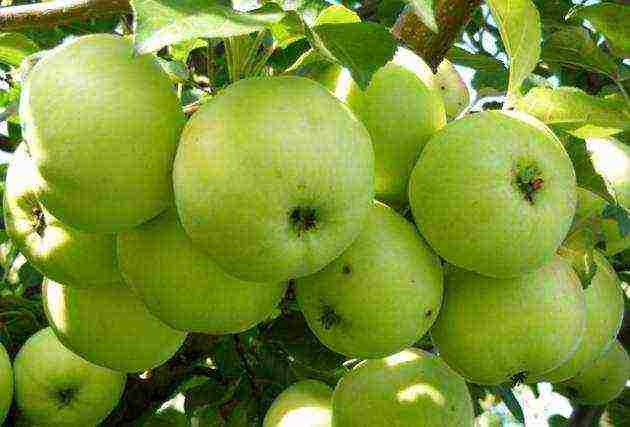
An old Russian variety of folk selection. Adapted to temperate, rather humid climates. Possesses high winter hardiness, is quite resistant to scab. Begins to bear fruit in the 5-8th year, but yields periodically after ten years; with good agricultural technology, it bears fruit annually and abundantly, sometimes up to 500 kg per tree.
The trees are vigorous, with a rounded, fairly branched crown. Branches from the trunk branch off at an obtuse angle, which provides a strong attachment to the trunk and helps to withstand the weight of the fruit. Fruits are above average (100-200 g). Larger on young trees.
The shape is oval-conical, round-conical or flat-round with wide ribs. The skin is greenish-yellow, smooth, shiny, with dense light subcutaneous punctures. The pulp of the fruit is white or yellowish, coarse-grained, juicy, wine-sweet. The fruits are harvested in the second half of September - early October. They acquire consumer maturity at the end of October, during storage. This is one of the varieties of apples stored until spring.
In ventilated cellars, it can be stored in straw until March. The fruits are consumed fresh, dried, soaked, used for making apple dough, marmalade, marshmallow, jelly and other blanks.
Winter varieties of apples stored until spring
Scarlet anise
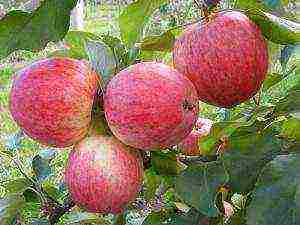
A variety of folk selection. Bred in the Middle Volga region. Widely distributed in non-chernozem areas. Differs in high winter hardiness - withstands frosts down to -45 ° С. Begins to bear fruit in the 5-7th year and gives good regular yields - up to 300 kg per tree. Drought-resistant, undemanding to the soil. It is resistant to scab, but during storage the fruits are damaged by "pepper".
The trees are vigorous, with a rounded crown. Fruits are below average (65 g). The skin is pale green, most of the surface is covered with a pink or red blurred blush and a bluish bloom. The pulp is yellowish-white, firm, sour-sweet on the palate. The fruits are harvested in late August - early September.Stored in the refrigerator until December. They are consumed fresh, used for making juices and jams.
Anise gray (Anise striped)
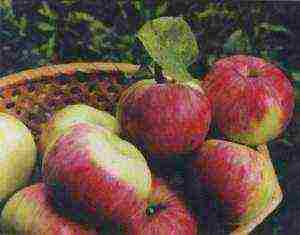
The variety of folk selection was bred in the Volga region. Differs in high winter hardiness. Drought-resistant. Begins to bear fruit in the 5-6th year and gives high yields - up to 500 kg per tree. Scab resistance is average: fruits and leaves are affected by it in rainy years.
The tree is vigorous, with a rounded pyramidal crown and drooping branches. Fruits are of medium and below average size (90 g). The skin is thin, shiny, greenish-yellow with an orange-red dull blush.
The pulp is greenish-white, moderately juicy, sour-sweet, with a characteristic pleasant aftertaste and aroma. The fruits are harvested in late September - early October. They are stored in the refrigerator until March, transportable. They are consumed fresh, soaked, dried, used for making juices and preserves.
Antonovka dessert
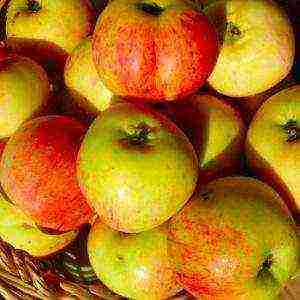
The variety was bred by crossing Antonovka ordinary and Pepin saffron. Winter hardiness is good, but slightly lower than that of Antonovka ordinary. Fruiting in the 4th-5th year after planting. Produces crops regularly. Scab resistance is high.
The trees are medium-sized, with a strong sparse crown. The fruits are large (150-200 g), round, with a small cone towards the top. The shape resembles the fruits of Antonovka ordinary, but more rounded. The color of the fruit is greenish-creamy with a very light, spilled speckled-striped red blush, the skin is dry. The pulp is medium-grained, juicy, fragrant, with an excellent sweet and sour taste. Fruits are harvested at the end of September, consumer maturity occurs at the end of October. They are kept in the refrigerator until March.
Aport
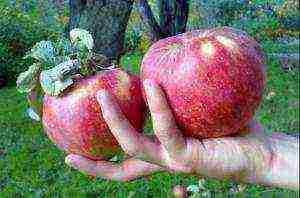
A variety of apples stored until the spring of national selection. We have the most common varieties of Aport: Aport Alexander and Aport blood-red. Winter hardiness and resistance of the variety to scab is average, the yield is not high enough, but in favorable conditions it is quite significant (on average, 200-300 kg per tree).
The trees are vigorous, with a wide rounded crown. They begin fruiting in the 6-7th year. Requires well-cultivated, dry soils. The fruits are large, even in the Moscow region there are specimens weighing up to 500-600 g. Their shape is narrow-conical or broad-conical, narrowed towards the apex, with weakly pronounced ribs.
The main color is light yellow with dark red stripes and specks (dark blush), in the blood-red Aporta it is carmine-red all over the apple. The skin is oily, very aromatic. The pulp is snow-white, loose, juicy, sweet and sour taste.
Apples are harvested in October, their consumer maturity does not come until November. Stored in the refrigerator until mid-February - March.
Cortland

The variety was bred in the USA. The winter hardiness of the tree is insufficient. Begins to bear fruit in the 5-6th year, then periodically gives good yields. Scab resistance is average. Fruits are of medium size (100-125 g), flat-round. The color is yellowish-green with a blurred striped dark red blush and a gray waxy bloom. The pulp is snow-white, fine-grained, juicy, with a delicate aroma. The fruits are harvested in early October.
Consumer maturity occurs in October-November. The fruits are stored in the refrigerator until April - May.
Lobo
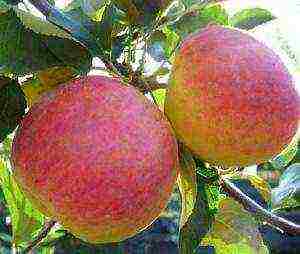
The variety was bred in Canada from seeds obtained from free pollination of the Mekintosh variety. Insufficient winter hardiness, as well as low scab resistance. The tree begins to bear fruit early, yields good yields every year.
The trees are medium-sized, with a rounded spreading crown. Young people grow up quickly, adults grow more slowly. Fruits are large and above average size (100-200 g), flat-round, with a small cone towards the top, dark red when ripe.
The pulp is white, tender, juicy, sweet and sour taste. Ripening later. In the middle lane, apples are harvested in late September - early October. Consumer maturity occurs during storage. Stored in the refrigerator until February - March.
Peaceful
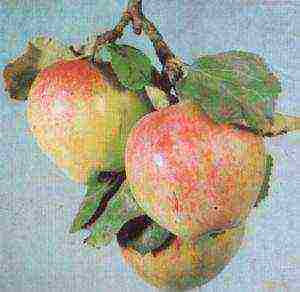
The variety was bred by crossing Antonovka ordinary and Jonathan. Differs in high winter hardiness. Begins to bear fruit in the 5-7th year. Periodically gives high yields. Scab resistant. The tree is vigorous, the crown is round, of medium density. The fruits are large (average weight up to 160 g). Under unfavorable weather conditions during the growing season and poor care, apples can be uneven and even small. Their shape is conical, with pronounced ribbing.
The main skin color is greenish-yellow with a bright red blush on the sunny side of the fruit. The pulp is reddish, juicy, sour-sweet, with a light spicy aroma. The fruits are removed in September - October, stored in the refrigerator until March.
Renette bergamot
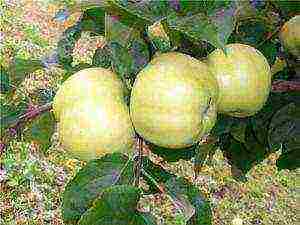
The variety was bred by IV Michurin, a vegetative hybrid of apple and pear. Differs in high winter hardiness. Begins to bear fruit in the 6-8th year after planting and gives high yields. Scab resistance is insufficient. Fruits are above average in size (150-200 g). The shape is flat-round, onion. The color is green when harvested, turns yellow in storage. The pulp is white, slightly greenish, firm, sweet and sour. The fruits are harvested in October. Consumer maturity occurs during storage. Stored in the refrigerator until May - June.
Rossosh striped
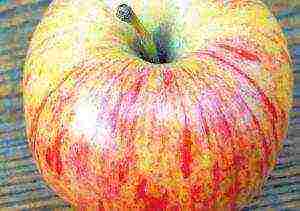
The variety is quite winter hardy. Begins to bear fruit in the 5-6th year after planting and yields high yields annually. Not resistant to scab. Fruits are large (up to 350 g), round-conical in shape, flattened from the side of the stalk. Their color is yellowish-green with a carmine-red, almost continuous blush. The pulp is greenish, has an excellent sour-sweet taste, with a pleasant aroma. The fruits are harvested in early October, they ripen during storage. Stored in the refrigerator until March - April.
North synap
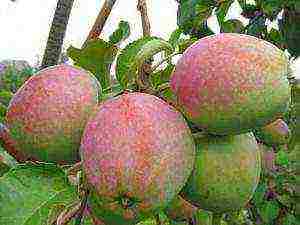
A variety with average winter hardiness, relatively resistant to scab. Begins to bear fruit in the 4th-5th year and gives high yields annually (120-170 kg). Fruits are above average (125 g), smaller in older trees. The skin is greenish-yellow with a blurred dark red blush. The pulp is white with a greenish tint, juicy, sweet and sour. The fruits are harvested in October. Their consumer maturity occurs in 2-3 months. In the refrigerator, apples can be stored until May - June, and sometimes until the next harvest. Sinap Orlovskiy The variety was bred by crossing the Northern Sinap and Pamyat Michurin varieties. Fairly hardy and fast-growing. The yield is average. Fruiting is regular. Relatively scab resistant. Fruits are above average size (125 g), oblong-conical in shape, with blunt ribs. The coloration is yellowish-green during the collection period, in storage it is golden-yellow with a slight reddish blush. The pulp is white, juicy, dense, sweet and sour. The fruits are harvested in late September - early October. Consumer maturity occurs during storage in November, they are stored in the refrigerator until April - May.
Common gooseberry
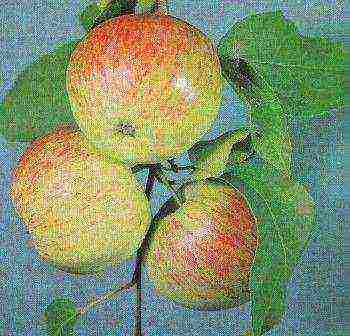
An old Russian variety of folk selection, has long been cultivated in central Russia. It has high winter hardiness and productivity, but is susceptible to scab. It begins to bear fruit in the 5-6th year after planting and gives a bountiful harvest every year. The tree is vigorous, forms a broad-pyramidal crown. Medium-sized fruits (100-120 g). Their shape is flat, flat-round, strongly ribbed, often irregular. The skin is green - with a brownish-red blush. At full maturity, the base color turns yellow.
The pulp is greenish or almost yellow, at first firm, then loose, very juicy. Apples are sweet in taste, almost without acid, with a specific aroma. Apples are harvested in the middle lane in late September - early October.
Consumer maturity occurs in November during the storage process. Stored in the refrigerator until March, sometimes much longer. The fruits are transportable.
Welsey

The variety was bred in the USA. Selected seedling of cherry crab.Widespread in our country, zoned in many areas. The resistance of trees to scab is very high. Average winter hardiness: in young trees it is higher than in adults. Wellsay begins to bear fruit early - in the 3-4th year, gives bountiful harvests annually, after which it needs pruning.
The trees are medium-sized, with rounded-conical crowns. Fruits are of medium and above average size (100-150 g), very regular flat-round shape, with dense skin.
The color is yellowish with a solid cherry-red blush. The pulp is white with a slightly greenish tinge, very juicy, crunchy, sweet and sour taste. The fruits are harvested in September. They are transportable. Ripening occurs in a month during storage. Stored in the refrigerator until the end of March.
Late winter apple varieties
Moscow winter
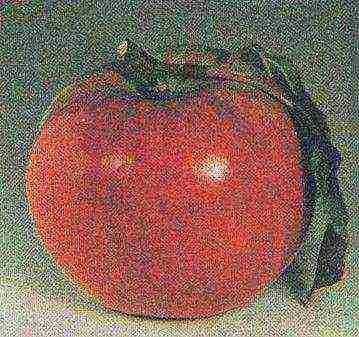
The variety was bred by crossing the Welsey and Antonovka varieties. Differs in high winter hardiness, scab resistance. Begins to bear fruit early, gives high yields.
The tree is medium-sized, well leafy. The fruits are very large and heavy. Average weight 220 g. Their shape is very regular, round-conical, without ribs. The color of the skin during the harvest is greenish, when ripe it is greenish-yellow with dark red strokes spread over the surface.
Numerous yellowish subcutaneous points are pronounced. The pulp is slightly creamy, sweet-sour taste, with a pleasant spicy aroma. The fruits are harvested in late September - early October. Consumer maturity occurs during storage in November - December. Apples can be kept refrigerated until April.
Memory of Michurin

The variety is bred from the seeds of the Champanren-Chinese variety. Average winter hardiness, but resistant to scab. The tree begins to bear fruit early and yields high yields annually, mainly on fruit twigs. The tree is vigorous, with a sparse, rounded, spreading crown. Fruits are above average, large on young trees (140 g), flat-conical, slightly ribbed or smooth. The skin is yellow with bright red blurred stripes. The pulp is juicy, fine-grained, sweet and sour. In the Moscow region, the fruits are harvested in late September - early October. They reach consumer maturity in October. Apples are stored in the refrigerator until April - May.
Source
